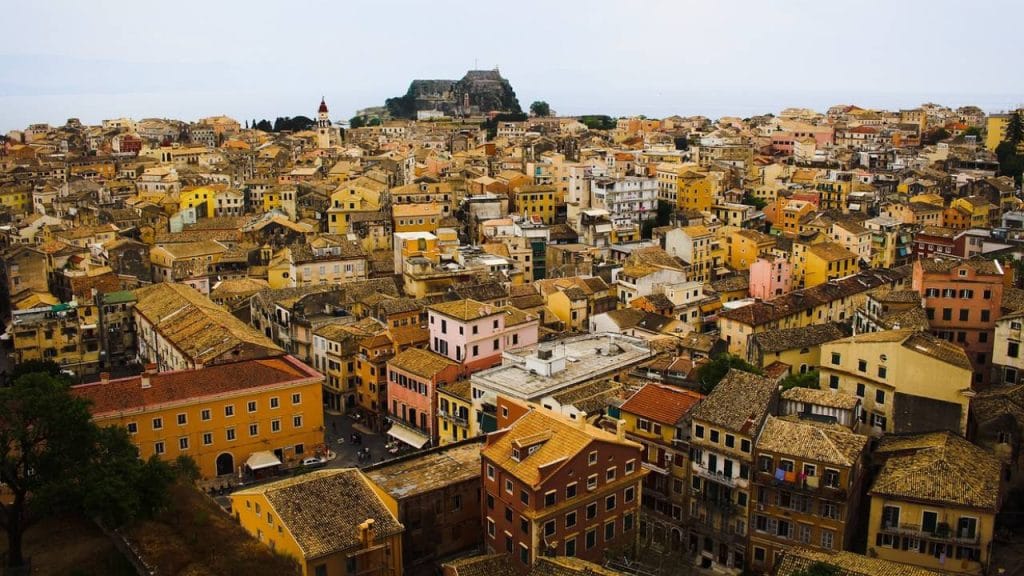
Table of Contents
Perched on a hillside in the village of Gastouri, 10 kilometers south of Corfu Town, the Achilleion Palace stands as one of Europe’s most romantic architectural achievements. Built in 1890 for Empress Elisabeth of Austria affectionately known as “Sisi” this neoclassical monument combines Greek mythology, imperial nostalgia, and breathtaking Ionian Sea vistas into an unforgettable experience.
Empress Elisabeth, The Tragic Beauty Behind the Palace
Elisabeth of Bavaria, Empress of Austria and Queen of Hungary, remains one of history’s most fascinating royal figures. Renowned for her extraordinary beauty, obsession with fitness, and rebellious spirit against Habsburg court protocols, Sisi sought refuge from Viennese formality in Corfu’s tranquil embrace.
After the tragic suicide of her only son, Crown Prince Rudolf, in 1889, Elisabeth commissioned the Achilleion as a personal sanctuary. She chose Corfu for its mild climate, Greek heritage, and distance from the suffocating Austrian court. The palace’s name honors her hero: Achilles, the legendary Greek warrior whose strength and vulnerability resonated with her own struggles.
Architectural Vision, Italian Artistry Meets Greek Mythology
Italian architect Raffaele Carito designed the palace in neoclassical Pompeian style, drawing inspiration from ancient Greek aesthetics. The result is a harmonious blend of pastel facades, ionic columns, ornate balustrades, and mythological motifs.
The Main Building
The Main Building features three floors with elegant proportions. Soft pink and cream tones dominate the exterior, while interior rooms showcase period furniture, crystal chandeliers, and original frescoes. Large windows frame panoramic views stretching from Corfu Town to the Albanian mountains across the strait.
The Chapel
The Chapel adjacent to the main palace displays Byzantine style icons and served as Elisabeth’s private place of worship. Its intimate scale contrasts with the palace’s grandeur, reflecting Sisi’s desire for spiritual solitude.
The Gardens, A Sculptural Journey Through Greek Mythology
The Achilleion’s terraced gardens descend the hillside in a carefully choreographed display of statues, fountains, and Mediterranean flora. Every sculpture tells a story from Greek mythology, creating an open air museum that rivals any European palace garden.
The Dying Achilles
The Dying Achilles by German sculptor Ernst Herter dominates the upper terrace. This deeply moving statue depicts the hero’s final moments, pulling an arrow from his fatal heel wound. Sisi personally commissioned this piece, identifying with Achilles’ vulnerability beneath his warrior exterior. The inscription reads: “AΧΙΛΛΕΥΣ ΘΝΗΣΚΩΝ” (Achilles Dying).
The Victorious Achilles
The Victorious Achilles, added later by Kaiser Wilhelm II, stands 11.5 meters tall near the palace entrance. This imposing bronze by Johannes Götz presents a contrasting vision—a triumphant warrior rather than Sisi’s vulnerable hero. The inscription quotes Pindar: “The greatest deed is to be brave.”
The Muses' Terrace
The Victorious Achilles, added later by Kaiser Wilhelm II, stands 11.5 meters tall near the palace entrance. This imposing bronze by Johannes Götz presents a contrasting vision a triumphant warrior rather than Sisi’s vulnerable hero. The inscription quotes Pindar: “The greatest deed is to be brave.”
Kaiser Wilhelm II Era, From Personal Retreat to Imperial Showpiece
After Elisabeth’s assassination in 1898, the palace changed hands several times before German Kaiser Wilhelm II purchased it in 1907. The Kaiser transformed Sisi’s intimate retreat into a more masculine, imperial statement.
Wilhelm II added:
– The monumental Achilles statue emphasizing victory over vulnerability
– A bridge connecting the palace directly to the beach below
– Extensive diplomatic facilities for hosting European dignitaries
– Military themed decorations reflecting Prussian tastes
The Kaiser spent spring vacations at the Achilleion from 1908 until World War I’s outbreak in 1914. His writing desk remains preserved, along with photographs documenting his stays.
Interior Highlights, Rooms Frozen in Time
The Grand Entrance Hall welcomes visitors with a double staircase, marble floors with geometric patterns, and ceiling frescoes depicting Apollo’s chariot. The imperial coat of arms from both Austrian and German periods coexist on the walls.
The Chapel Room features Elisabeth’s personal prayer space with Byzantine icons and an ivory crucifix. This intimate chamber reveals her deeply spiritual nature.
The Royal Bedrooms display period furniture, personal items, and photographs of Sisi and her family. The Empress’s bedroom overlooks the gardens she personally designed.
The Hall of Mirrors reflects both architectural elegance and Elisabeth’s well-documented obsession with her appearance. She reportedly spent hours daily maintaining her legendary beauty.
The Museum Rooms on the upper floor contain Elisabeth’s personal effects, including leather gymnastics equipment (she had training rings installed in her Vienna apartments), portraits, and correspondence revealing her complex personality.
Panoramic Views, Why Location Matters
The Achilleion’s elevated position provides 360-degree views that captivated both Elisabeth and Wilhelm II:
– East: Corfu Town’s Venetian fortresses and the Old Town’s terracotta roofs
– West: The Ionian Sea stretching toward Italy
– North: Mount Pantokrator, Corfu’s highest peak
– South: Rolling olive groves and coastal villages
Sunset from the Achilleion’s terraces ranks among Greece’s most spectacular vistas, with golden light illuminating both palace and sea.
Getting There, VIP Electric Transfer Experience
Located in Gastouri village, the Achilleion sits approximately 12 kilometers from Corfu Airport and 10 kilometers from Corfu Town. VforVIP’s electric van service offers the perfect way to reach this hilltop masterpiece.
Our zero emission vehicles navigate Corfu’s winding roads smoothly and quietly, allowing you to enjoy the journey through olive groves and traditional villages. Unlike crowded tour buses, our VIP service provides:
– Direct door-to-door transfer from airport or accommodation
– Flexible scheduling around your itinerary
– Comfortable climate-controlled environment
– Knowledgeable drivers sharing local insights
– Sustainable travel aligned with modern eco-tourism values
The scenic route passes through authentic Corfiot villages, offering glimpses of island life unchanged for generations.
Visiting Information
– Opening Hours: Daily 8:00 AM – 8:00 PM (summer), 8:30 AM – 3:30 PM (winter)
– Admission: €10 adults, €5 reduced, free for children under 12
– Duration: Allow 2-3 hours for comprehensive exploration
– Best Time: Early morning (8-10 AM) or late afternoon (5-7 PM) for fewer crowds and ideal photography light
– Accessibility: Ground floor and gardens accessible; upper floors require stair climbing
– Photography: Permitted throughout tripods allowed in gardens
– Facilities: Gift shop, café with terrace seating, restrooms, free parking
Cultural Significance and Modern Use
Beyond tourism, the Achilleion serves as a venue for international summits, classical music concerts, and cultural events. The 1994 European Union summit took place here, and the gardens regularly host the Corfu Festival’s outdoor performances.
The palace appeared in the 1981 James Bond film “For Your Eyes Only,” introducing millions to its cinematic beauty. The famous casino scene was filmed in the main hall, though no actual casino exists at the location.
Combining Your Visit
The Achilleion pairs perfectly with nearby attractions:
Gastouri Village: Traditional kafeneions and authentic tavernas within walking distance
Benitses: Coastal village 3 km away with excellent seafood restaurants
Kanoni and Pontikonisi: 20 minutes drive to Corfu’s iconic Mouse Island viewpoint
Corfu Town: Easy combination for a full day cultural tour
VforVIP can arrange customized itineraries combining multiple destinations with our comfortable electric transport, maximizing your time while minimizing environmental impact.



